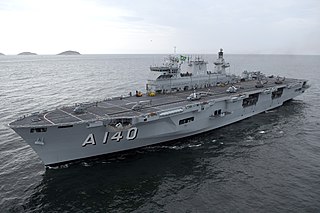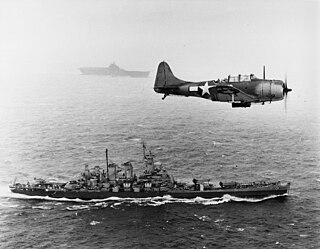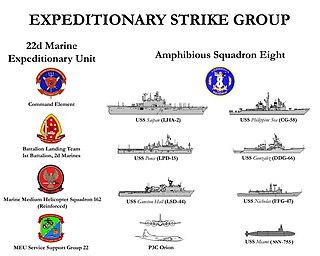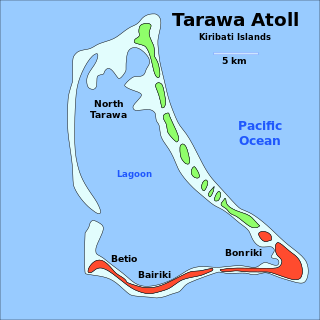Two United States Navy ships have borne the name Tarawa, after the Tarawa Atoll that was the scene of a bloody fight in the Pacific War.

The Tarawa class is a ship class of Landing Helicopter Assault (LHA) type amphibious assault ships operated by the United States Navy (USN). Five ships were built by Ingalls Shipbuilding between 1971 and 1980; another four ships were planned, but later canceled; instead they were joined by the Wasp-class amphibious assault ships.

The Wasp-class is a class of landing helicopter dock (LHD) amphibious assault ships operated by the United States Navy. Based on the Tarawa class, with modifications to operate more advanced aircraft and landing craft, the Wasp-class is capable of transporting almost the full strength of a United States Marine Corps Marine Expeditionary Unit (MEU), and landing them in hostile territory via landing craft or helicopters as well as providing air support via AV-8B Harrier II attack aircraft or F-35B Lightning II stealth strike-fighters. All Wasp-class ships were built by Ingalls Shipbuilding, at Pascagoula, Mississippi, with the lead ship, USS Wasp, commissioned on 29 July 1989. Eight Wasp-class ships were built, and as of April 2021, seven are in active service, as USS Bonhomme Richard was seriously damaged by fire on 12 July 2020, and subsequently decommissioned in April 2021.

Landing platform helicopter (LPH) is a term used by some navies to denote a type of amphibious warfare ship designed primarily to operate as a launch and recovery platform for helicopters and other VTOL aircraft. As such, they are considered a type of helicopter carrier.

Tarawa is an atoll and the capital of the Republic of Kiribati, in the Micronesia region of the central Pacific Ocean. It comprises North Tarawa, which has 6,629 inhabitants and much in common with other more remote islands of the Gilbert group, and South Tarawa, which has 56,388 inhabitants as of 2015, half of the country's total population. The atoll was the site of the Battle of Tarawa during World War II.

Landing helicopter assault (LHA) is the United States Navy's hull classification symbol for the general-purpose helicopter-carrying amphibious assault ships of the Tarawa and America classes.

The Iwo Jima-class amphibious assault ships of the United States Navy were the first amphibious assault ships designed and built as dedicated helicopter carriers, capable of operating up to 20 helicopters to carry up to 1,800 marines ashore. They were named for battles featuring the United States Marine Corps, starting with the Battle of Iwo Jima. The first ship of the class was commissioned in 1961, and the last was decommissioned in 2002. The hull classification of "LPH" stands for "Landing Platform Helicopter".
Makin Island may refer to:

USS John Rodgers (DD-574) was a Fletcher-class destroyer of the United States Navy commissioned during World War II and the second ship to bear the name. She was named after three members of the Rodgers family who served in the Navy from the War of 1812 through World War I. John Rodgers served in several wartime actions in the Pacific, receiving 12 battle stars.

The Gilbert and Marshall Islands campaign were a series of battles fought from August 1942 through February 1944, in the Pacific theatre of World War II between the United States and Japan. They were the first steps of the drive across the Central Pacific by the United States Pacific Fleet and Marine Corps. The purpose was to establish airfields and naval bases that would allow air and naval support for upcoming operations across the Central Pacific. Operation Galvanic and Operation Kourbash were the code names for the Gilberts campaign that included the seizures of Tarawa and Makin, during the Battle of Tarawa on 20–23 November 1943 and the Battle of Makin on 20–24 November 1943. Operation Flintlock and Operation Catchpole were aimed at capturing Japanese bases at Kwajalein, Eniwetok, and Majuro in the Marshall Islands.

The America class is a ship class of landing helicopter assault (LHA) type amphibious assault ships for the United States Navy (USN). The class is designed to put ashore a Marine Expeditionary Unit using helicopters and MV-22B Osprey V/STOL transport aircraft, supported by AV-8B Harrier II or F-35 Lightning II V/STOL aircraft and various attack helicopters. The first of these warships was commissioned by the U.S. Navy in 2014 to replace USS Peleliu of the Tarawa class; as many as eleven will be built. The design of the America class is based on that of USS Makin Island, the last ship of the Wasp class, but the "Flight 0" ships of the America class will not have well decks, and have smaller on-board hospitals to provide more space for aviation uses.

In the United States Navy, the expeditionary strike group (ESG) is a coordinated group of surface ships, aircraft, submarines, and other naval assets. In contrast to carrier strike groups (CSGs), which emphasize air power and are led by a supercarrier, ESGs are strongly suited for amphibious warfare and are led by an amphibious assault ship. The ESG concept was introduced in the early 1990s, based on the Naval Expeditionary Task Force. The U.S. Navy fields nine expeditionary strike groups.

An amphibious assault ship is a type of warship employed to land and support ground forces on enemy territory during an armed conflict. The design evolved from aircraft carriers converted for use as helicopter carriers. Modern designs support amphibious landing craft, with most designs including a well deck. Like the aircraft carriers they were developed from, some amphibious assault ships also support V/STOL fixed-wing aircraft and have a secondary role as aircraft carriers.
Saipan is a Pacific island that is part of the Mariana Islands archipelago. It is one of the 14 islands that constitute the Northern Mariana Islands, an unincorporated territory of the United States.

USS Tripoli (LHA-7) is the second America-class amphibious assault ship built for the United States Navy. On 7 May 2012, United States Secretary of the Navy Ray Mabus announced the ship's name as Tripoli, in honor of the US Marine Corps victory against Tripoli at the Battle of Derna during the First Barbary War. This is the third US Naval ship to carry the name, the first being USS Tripoli (CVE-64), an escort carrier from World War II and the second being USS Tripoli (LPH-10), an amphibious assault ship that served during the Cold War.

USS Bougainville (LHA-8) is an America-class amphibious assault ship currently under construction for the United States Navy. She will be the second Navy ship to be named Bougainville.

Naval Base Tarawa was a naval base built by the United States Navy in 1943 to support the World War II effort. The base was located on Tarawa atoll in the Gilbert Islands in the Central Pacific Ocean. The base was built as one of many advance bases in the island-hopping campaign towards the Empire of Japan. At Naval Base Tarawa the Navy built a seaport, seaplane base and two airbases. Construction started after the Battle of Tarawa ended November 23, 1943, part of Operation Galvanic.

The AN/SPN-35 is a computerized automatic landing system installed on the Tarawa-class amphibious assault ship and other LHA/LHD-class warships to give control for aircraft during the final approach and landing.














